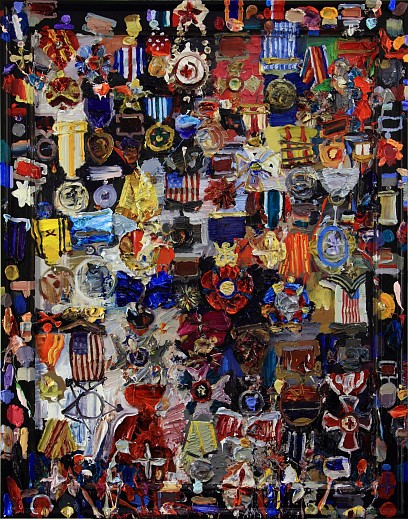
Nigel Mullins: Artthrob Review
November 27, 2017 - Dave Mann
Inside and Outside the Image: Nigel Mullins’ ‘Artefacts from the Anthropocene’
By Dave Mann
November 21, 2017
01.11-25.11.2017
Images, at one level, document moments in time. They can come to represent how we remember and understand those moments. In the globalised image-intensive world, we tend to attach an unquestionable significance and sometimes faith to the images we see the most. We know this, but most of us tend to do little about it. Nigel Mullins knows this too.
In ‘Artefacts from the Anthropocene,’ at CIRCA Joburg, Mullins attempts to immerse himself in making sense of history. Through images of mass gatherings, political figureheads and social evolutions, Mullins invites us to consider the weave of history and its hierarchies. He’s done the footwork, the antique crate-digging, that allows viewers to journey through the Anthropocene – the age of human changes on a global scale – and consider what’s next.
‘Mass gatherings are a persistent global phenomenon,’ explains Mullins. ‘They are, for me, totally emblematic of the human-dominated now, of a global existential state. History is proof that something has to happen, one thing will always lead to another with no plausible end in itself. In a sense, I want the paintings to be outside history, not indifferent, but embroiled and fascinated.’
Mullins’ show reminds you to take a step back and consider your knowledge of history and power, and how it has been informed by a few prominent images via books, screens and posters.
Mullins paints thick, oily renditions of political leaders such as Mao Zedong and Fidel Castro, war-time medals from across the globe caked onto canvas, and densely-populated vignettes of protests, inaugurations, and celebrations. The range of images gives the show a museum-like quality. But the materials of his work offer a different narrative. Brittle frames, twisted wire fixings and bold, chunky gatherings of paint scratch at surfaces, investigate prevailing narratives, and draw moveable, applicable themes to our shared histories.
In the painting, Portrait of Chairman Mao for example, Mao’s face is smudged, distorted and contained by a chipped and ageing frame. It is an immediately recognisable image, but the way Mullins recreates it puts forward the idea that the image you know, may not represent the truest version of history. It is beneath these layers of paint and outside of these crumbling frames, where the full story can be found. Instead of telling you how things happened, what people did, and when events took place, the works prompt you to question the myth of an image. They call into question, what’s taking place both inside and outside of a single image.
You’ll see this again in paintings such as Artefacts from the Age of Conquest and Antecedents to the Heroic Global Order which make use of wartime medals in their original colours and shapes. By using images of medals – emblems that signify power, history, and moment – Mullins touches on the overwhelming archive of images that bear their own versions of mythical history.
In works such as in Inauguration, which puts forward a scene of hundreds of people gathered in a single frame, the myth of the image can even appear dreamlike. You can’t see the faces of the subjects, but you know, somehow, the energy of the crowd and the atmosphere of the day – like a story you’ve heard before, or a dream you can only recall parts of.
‘History has no end,’ Mullins says. ‘It’s not a means towards an end. But our understanding of the complexity that we are in is shaky.’
Back to News



